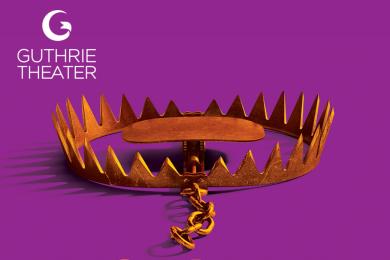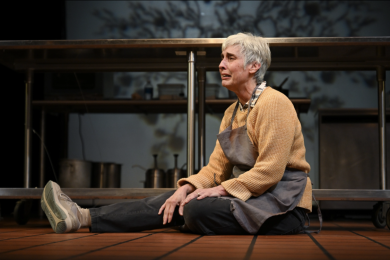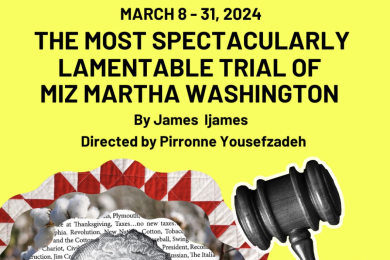After words: From the conversations we have at the theater, afterwards.
I love the theater and wouldn't mind seeing remounts of almost any plays I've read or heard about, from an obscure Russian turn-of-the-century playwright to the very first theatrical description of a dinosaur hunt. Still, no matter what, I'm more excited and usually more satisfied when I see a new play than I am to see any classic performed by our mid- to large-sized institutional (museum) theaters, regardless of the production quality of either the new play or the classic. Old plays speak to the theater lover in me; new plays actually speak to me. (With a large exception made for the new plays usually presented by those same institutions—those new plays have somehow been washed free of blood and polished until they're as irrelevant as the older plays they're displayed alongside.)
Sure, classic plays have the power to reach across time and blow my mind apart, but that's really hard to do, and they rarely do. New plays (the ones I mean, the ones that haven't been made to look approximately like the old plays only with Faeebook references) don't have to be that good to be worthwhile; they simply have a shorter distance of time, space, and subject to travel in order to really land.
All of this is by way of introduction to some after show thoughts on the Guthrie's
Singled Out festival in the Dowling Studio. Friday and Saturday last weekend, I saw all four shows, purposefully spending more time at the Big G than I have since the TCG conference in, what?, 2007 I think, when I vowed never to spend that much time in the Guthrie again. (Sadly, the space doesn't wrap a person in warmth the way perhaps its builders intended.) I love new plays that much and think that regardless of what a critic might conclude about each play individually—and regardless of any comparison we might make to the sacred Canon of Theatrical Literature (otherwise known as the place we go to justify our subjective, nostalgic feeling that they just don't make plays as good as they did when we first saw theater), each play in
Singled Out is worth seeing and absolutely worth talking about afterword.
Creating new plays
Here's a thought: All four plays were created by small companies who perform a lot in unconventional venues, or the Fringe Festival or both, so from beginning to end, they haven't been touched by the regional theater system. And, thankfully, they retain their own character nicely—whatever you think of that character and whatever it might be, it feels wholly different from what you might normally see at the G. Yet, still, all of them, even the one I enjoyed least, were put together by theater-making people who were clearly professional enough to stand on a Guthrie stage and not embarrass the G Board of Directors. Whether the Board actually wants to see plays about rock magicians and over-sexed college kids is a question I'd like to ask them. If not, why not? If so, why not more?
Here's another thought: Three of the four plays critiqued cultural phenomenon that have become or have always been sort of self-satirizing.
The Black Arts, while poking at an interesting question about why we enjoy watching things that we know are faked, milks a lot of mileage out of the ludicrousness of the new "hard rock" magician. I kind of doubt that the real audience for that stuff is at all confused by its ludicrousness, drawn in by its pretension. They just probably feel that the bombast is fun and the tricks are cool to watch.
The subject for Sandbox's
June of Arc is shockingly well-worn (
Leave it to Beaver, for cryin' out loud). And
American Sexy is, at times, like watching a
Girls Gone Wild commercial—which are clearly loaded with their own sense of irony and oddly confusing self-awareness, even amid all the seeming spontaneity and giddy "wildness."
Each play does other things too—and does them well—but they still made me wonder why we feel the need to go to the theater to throw darts at already pock-marked targets. It's not a rhetorical question: Is this how we process our reaction to popular cultural experiences? Am I assuming too much about the audience? Is a "heightening" and exaggerating of hard rock magic's conventions, for example, a necessary tonic to commercial magic's absurdity? I have sometimes written plays that take place in universes similar to but different than our own, in parallel universes. Have I missed the point of theater? Should I pick a hot cultural phenomenon instead and do the mirror-held-up-to-society thing?
Audience and death
Mortum Capiendum by Four Humors Theater takes place in a kind of parallel universe to our own—sort of in the past where medicine shows existed but also, in many ways, more completely present in the theater than any of the other shows. (Is this why I liked this one the most of all four? Because it is the type of play that I thought I would write—or wish I had written.) Though I don't want to be a critic, and the purpose of this blog is more to share thoughts than critique, I just want to say (yet again) how much I admire this show: the writing is sharp and confident, original and smart. It's as close to a modern Marx Brothers show as you will ever see. Yes, it is.
There are some interesting ideas in there too about what makes us human, what makes life worth living (Does Death actually make Life worth living?), about how we distinguish ourselves as individuals, plus a few very sharp barbs at where greediness will get you in the end, but none of it is done with a big neon sign floating overhead saying "This is our theme! Pay attention!" I loved how the pleasures of this production switched from witty dialogue to nice physical comedy to unexpected plot twists to casual, seemingly improvisational segments with the audience to whatever they could think of next. It was all kind of virtuosic and yet not particularly full of itself.
I saw it on Saturday afternoon at 1 p.m. with the smallest crowd I've ever seen at a Four Humors show. I don't know what it means that the Fringe Festival can always find a larger audience for a company like Four Humors than the Guthrie. (I'm sure something about the audience size had to do with the hour but still. . . )
At some point, while watching the show, I realized that the guy across the aisle from me was periodically breaking out in hysterical laughter. Then I realized that I was doing that too, occasionally almost falling out of the my chair. There was a crowd of people, audience right and closer to the stage, who were also loud and excited about how much they were enjoying the show, and then I finally noticed that around half the audience (the older half) didn't appear to be moving at all. They had their arms folded. They sat in their seats rigidly, and the ones I could see had, maybe, slight smiles on their faces. I think they were enjoying it, and I couldn't see everyone's faces, but it did seem like a good half of the audience was oddly unresponsive. (Again, could have been the hour.)
Mortum Capiendum has no swear words. It takes place, vaguely, during the Depression. It's high-spirited, light-hearted, and unpretentious. You'd think this would be the perfect show for a wide range of audience members, yet for some reason, at least when I saw it, there was a real noticeable divide between audience members generally under and over 45 years old.
June of Arc, on the other hand, felt as though it landed right in the wheelhouse of the Guthrie audience—even though the production would probably be called more experimental, abstract, and "physical" theater (whatever the hell that means). Was it because the audience could immediately connect with the 50s television subject matter? Was it because Heather Stone, dressed up as June Cleaver, with her short haircut and smile, looked like a lot of the women in the audience? Was it because, thematically, it trod over ground we all kind of understand immediately, that representations of life in the early days of television marginalized and left out a whole helluva lot of real experience? (A literary manager at a big regional theater once told me that his audiences could only handle one "new" thing at a time. In
June of Arc, he'd probably say that the one new thing was the style of performance rather than the theme.)
By the way,
June was exceptionally well-performed (wow, Heather Stone!), well-conceptualized, well-realized. That of course shouldn't be discounted when considering why it worked so well in the Dowling Studio. I'm just curious why it seemed to fit so much more naturally than an equally well-done show like
Mortum Capiendum. (Again, just the time of day?)
Just wondering: This is the fourth show I've seen in the last twelve months that has performed or shown real old commercials as part of the performance. Apropos of nothing, why do audiences love this so much?
How do we nurture real originality?
One final thought: Somewhere in the middle of the New Theatre Group's
American Sexy by Trista Baldwin, a light bulb went off in my head, and I thought I understand better what Trista was doing. And it made me wonder about whether we actually try to understand what writers are doing anymore. (Jay Gabler's review on tcdailyplanet.net, for example, criticized parts of it as not "particularly authetic." Authentic to what?)
Trista writes seemingly naturalistic characters who interact in complex character-driven ways, then she also integrates a certain type of archetypal symbolism into the play as it goes along, weaving the characters away from naturalism toward a more abstract, elaborate and globalized poetry where they become more like instruments in a composition than distinctive characters in a realistic world. 20th century drama is indebted to Freud, and all that subtext/subconscious/ego/id talk; Trista's plays are baldly Jungian, with a lot of talk about universal symbols, undergirded by concepts of the collective unconscious, and dramatized with a lot of archetypal activity and gestures. In other words, it gets kind of weirder as it goes along, stylistically and narratively.
But I've known Trista since 1997. I know this is not an accident. This is what she wants to do.
It's very easy, however, for a critic or an audience member or a dramaturg or an Artistic Director to look at her plays and say,
Your characters are so great. Your subjects are so topical. Your passion so palpable. If only you would stop being so something weird there as you go along; you just kind of lose us in the end. And this isn't necessarily an inaccurate assessment (for many people). If Trista wrote more conventionally, she may already be more successful than she is.
But (and I think this is coming full circle finally), I believe we lose the potential for truly new and relevant work when
we see variation as imperfection, when we define new as only "recently made" rather than "never before seen."
Trista is truly original, combining elements other people wouldn't even think of. The parts we understand least are, in many ways, what motivates her to write in the first place. Wouldn't we be better off in the theater, when we know we've discovered a writer we like, to tried to understand and even accentuate her originality rather than judge whether her play worked exactly as effectively as a different play about a similar subject might have worked on us?
I think the biggest rewards for me when I see new work is this opening to someone else's vision of the contemporary world. I know that classics provide great storytelling experiences, and I value them, but new work actually turns my brain on to all kinds of truly new and wonderfully original ideas that are easier for me to bring back into the world I actually live in.
And so I barely think about whether they're perfect or imperfect, great or just pretty darn good, a future classic or just really worth doing right now.


